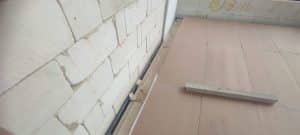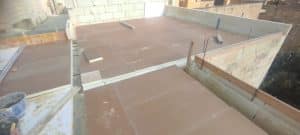Microcement has become a rising star in modern interior and exterior design. From sleek bathrooms to minimalist kitchens and stylish commercial spaces, its smooth finish and seamless appearance have made it a go-to choice for architects, designers, and homeowners alike. But one pressing question remains: is microcement waterproof?
The short answer? Not by itself. Microcement on its own is not inherently waterproof—but here’s the important part: with the correct professional sealing process, it becomes fully waterproof and safe for wet environments like showers, pools, and even outdoor terraces.
In this post, we’ll dig into five essential facts every homeowner, designer, or contractor in Malta should know when it comes to microcement’s waterproof capabilities—and what to expect when investing in it.
1. Understanding Microcement: What Is It Really?| Is Microcement Waterproof
Before we tackle whether microcement is waterproof, it helps to understand what microcement actually is.
Microcement is a cement-based coating that can be applied in thin layers (typically 2–3 mm thick) over a variety of surfaces—tile, plaster, concrete, wood, or even metal. It’s composed of cement, resins, additives, and mineral pigments, making it incredibly versatile for walls, floors, and even furniture.
But here’s the thing: while microcement is strong, flexible, and seamless, it’s not naturally waterproof. Like any porous cementitious material, it can absorb moisture if left unsealed. This is why sealing plays such a vital role in microcement applications.
2. The Truth About Waterproofing: Sealer Is Key| Is Microcement Waterproof
Let’s be clear: if you’re asking is microcement waterproof, the technical answer is no—until it’s sealed. But once a high-quality polyurethane or epoxy-based sealer is applied, the surface becomes completely waterproof and highly resistant to stains, moisture, and chemicals.
At Kibitec, we ensure every microcement installation includes a premium-grade sealer. This final step acts as a barrier, blocking out water, oils, and other contaminants—making microcement suitable for high-humidity or fully wet environments like:
Bathroom walls and floors
Kitchen countertops
Shower enclosures
Outdoor patios
Pool surrounds
Without a proper sealant, water could seep through the microcement over time, potentially causing issues like mold, bubbling, or surface degradation.
💡 Expert tip: Never skip the sealer. A high-quality sealer doesn’t just waterproof the surface—it also enhances durability and ease of maintenance.
3. Where Waterproof Microcement Works Best in Malta| Is Microcement Waterproof
Malta’s warm Mediterranean climate and coastal proximity make moisture management an essential factor when selecting finishes for your home or business. If you’re considering microcement, understanding where it works best as a waterproof material will help you make smarter design decisions.
a) Bathrooms & Wet Rooms
Want that sleek, spa-like aesthetic? Microcement is ideal for showers, sinks, walls, and floors when sealed properly. Its seamless finish means no grout lines, which also means less mold buildup—perfect for Malta’s humid interiors.
b) Kitchens
Cooking areas often involve spills, splashes, and stains. With waterproof microcement, your countertops and backsplashes not only look stunning but are also easy to clean and resistant to liquid damage.
c) Outdoor Spaces
Sealed microcement resists UV rays, rain, and temperature swings, making it an excellent option for terraces, rooftops, and balconies. Its slip-resistant finish is an added bonus for safety during rainy days.
4. Application Matters: Why You Need a Specialist| Is Microcement Waterproof
If you’re wondering “is microcement waterproof in all situations?” the truth is: only when it’s installed correctly.
Waterproofing is not just about slapping on a sealant. It involves:
Proper substrate preparation: the surface underneath must be stable and free from cracks or moisture.
Layered microcement application: applied in multiple thin coats for strength and uniformity.
Professional sealing: using a polyurethane or epoxy resin with at least two coats for full coverage.
Inexperienced application can lead to micro cracks, uneven surfaces, or failed sealing—which ultimately compromises the waterproofing.
👉 That’s why it’s essential to work with professionals who understand the process from start to finish. At Kibitec, we offer expert microcement application in Malta, ensuring both beautiful and functional results that last.
5. Cost Considerations: Is Waterproof Microcement Worth It?| Is Microcement Waterproof
By now, you may be thinking, “This all sounds great, but what’s the cost?”
In Malta, microcement installations—when done with professional waterproofing—start at around €65 per square meter. This includes material, labor, and sealing.
While it may be more expensive than traditional tiles or paint, the benefits make it worth the investment:
Long-lasting durability
Modern, minimalist look
Seamless and hygienic finish
Waterproof and easy to clean
Custom colors and textures
For high-moisture environments, trying to cut corners with cheaper alternatives can often lead to higher maintenance and replacement costs in the long run.
And let’s not forget: microcement can be applied over existing surfaces, meaning you often save on demolition costs, making it surprisingly cost-effective for renovations.
Is Microcement Waterproof? The Final Verdict| Is Microcement Waterproof
To bring it all together: microcement itself is not waterproof—but once sealed, it absolutely is.
If you’re planning a bathroom remodel, new kitchen, or outdoor upgrade in Malta and want a finish that is as functional as it is beautiful, waterproof microcement is a smart choice—as long as it’s professionally applied and sealed.
So, the next time someone asks “is microcement waterproof?” you’ll know the right answer: Not naturally—but with a proper sealant, it becomes fully waterproof and ready for any space, from the bathroom to the balcony.
Common Questions About Waterproof Microcement in Malta| Is Microcement Waterproof
When it comes to waterproofing and microcement, there are still plenty of questions floating around—especially if you’re renovating your home or upgrading a commercial space in Malta. Let’s tackle a few of the most common ones.
💬 Can I Use Waterproof Microcement in My Shower?
Yes, absolutely. When properly sealed, microcement is ideal for shower walls and floors. Its seamless, grout-free finish not only creates a minimalist aesthetic but also prevents the growth of mold and mildew—a common issue in tiled showers.
With the correct waterproofing layers applied by professionals, water won’t seep into the surface or substrate. That means no leaks, no rot, and no future headaches.
💬 Is It Slippery When Wet?
One of the great things about microcement is its customizable texture. While polished finishes may appear slippery, installers can adjust the aggregate size or apply a matte or satin finish to boost slip resistance.
At Kibitec, we always take into account how the space will be used. For bathrooms, kitchens, or pool areas, we use techniques that enhance grip, providing safety without compromising on style.
💬 How Long Does the Waterproof Sealer Last?
A good polyurethane sealer can last anywhere from 5 to 10 years, depending on the area’s usage and exposure to water or cleaning agents. For example, microcement in a guest bathroom might last closer to 10 years without a touch-up, while a heavily-used commercial kitchen might need re-sealing sooner.
The good news? Reapplying a new coat of sealer is straightforward and far less invasive than replacing tiles or redoing paint.
💬 How Do I Clean Waterproof Microcement?
Keeping sealed microcement clean is easy—another reason why it’s perfect for busy households or high-traffic businesses.
Here’s what we recommend:
Use a pH-neutral cleaner to avoid breaking down the sealer over time.
Avoid abrasive tools like steel wool.
Clean up spills quickly to preserve the surface finish.
For outdoor areas, a pressure washer on low power works wonders.
No harsh chemicals, no scrubbing grout—just wipe and go. Your future self will thank you.
Real-World Case Study: Microcement in a Maltese Seafront Villa
Let’s take this concept out of theory and into real life. A Kibitec client recently renovated a luxury villa in Mellieħa, just minutes from the beach. Their primary concern? Humidity.
They wanted a cohesive, waterproof material for their master bathroom, pool terrace, and kitchen, and they didn’t want to deal with moldy grout or water stains on tiles.
We proposed microcement, fully sealed and color-matched across the three spaces for a consistent aesthetic.
Here’s how it turned out:
The bathroom features smooth microcement floors and walls with a satin sealer for slip resistance.
The kitchen countertops were sealed with a high-performance polyurethane, perfect for hot pans and messy cooking.
The pool deck includes a textured microcement finish that resists both UV rays and saltwater splash.
Result? A seamless, waterproof design with minimal maintenance—and a very happy client.
Why Microcement Is a Smart Waterproofing Choice for Malta
Malta’s unique blend of salty sea air, high humidity, and Mediterranean sun demands durable, low-maintenance building materials. Waterproof microcement ticks all the boxes for both style and functionality.
Here’s why it’s a smart investment:
No joints or grout lines: Less mold, less cleaning, and a clean modern look.
Custom finishes: Choose your texture, color, and gloss level.
Waterproof when sealed: Perfect for wet zones indoors and out.
Applies over existing surfaces: No demolition, no dust clouds.
Compatible with underfloor heating: Great for comfort during cooler winter months.
Plus, its durability in wet or outdoor spaces makes it ideal for coastal properties or restaurants with terrace dining.
Want to see what’s possible? Contact us here and we’ll guide you through samples, colors, finishes, and waterproofing options.
Microcement vs. Tiles: Which is Better for Waterproofing?
Let’s settle this once and for all.
| Feature | Microcement | Traditional Tiles |
|---|---|---|
| Waterproof | Yes, when sealed | Yes, but grout lines can fail |
| Grout lines | None | Many |
| Maintenance | Low | Medium to high |
| Installation time | 4–7 days | 5–10 days |
| Aesthetics | Seamless, modern | Patterned or classic |
| Cost (€/m²) | From €65 | From €40–€90 |
| Resurfacing | Easy | Difficult |
| Surface compatibility | Almost any substrate | Requires flat, clean base |
Tiles have their place, but for seamless, waterproof, low-maintenance style—microcement takes the lead.
A Quick Note on Construction Standards
When applying microcement in wet areas, it’s essential to follow proper construction techniques and waterproofing standards. This includes correct joint sealing, vapor barriers where necessary, and industry-grade sealers.
We always recommend working with experienced applicators who understand Malta’s climate, humidity levels, and substrate conditions.
Want to dive deeper into the broader world of building practices? This construction overview on Wikipedia is a great place to start learning how modern materials like microcement fit into today’s industry standards.
Final Thoughts: Is Microcement Waterproof?
So, let’s bring it all home.
Is microcement waterproof?
✅ Not in its raw state
✅ But once sealed, yes—it’s fully waterproof
✅ Ideal for bathrooms, kitchens, pools, outdoor spaces
✅ Durable, hygienic, and easy to maintain
✅ Perfect for Malta’s climate and lifestyle
Just remember: proper installation is everything. Don’t compromise on quality. Whether you’re renovating a family home in Sliema or upgrading a boutique hotel in Gozo, microcement—when professionally sealed—offers waterproof performance and stunning style in one.
Ready to Waterproof Your Space with Style?
If you’re planning a bathroom renovation, a poolside upgrade, or a sleek kitchen redesign in Malta, microcement might just be your perfect material.
At Kibitec, we specialise in microcement application tailored to Malta’s unique conditions. We handle every step—from substrate prep and layering to professional waterproof sealing.
📩 Let’s talk about your project!
Get in touch with us today →




